The week before last, our home was up in the air next to Emerald Harbor Marine‘s shop at Canal Boatyard in Ballard. Although we’re happy to be back at Bell Harbor, we had a good week. Living aboard in the yard was an adventure, and we enjoyed exploring Ballard and visiting its many pubs. We’d lived on the 4087 while it was in the yard last fall, but the 52 is so much nicer. Grey water tanks make a major difference–we can shower on the boat and live almost normally so long as we minimize the waste water. The boatyard is on freshwater behind the Ballard Locks. Our initial plan was to go through on Sunday night in preparation for a haul-out on Monday. But we decided to go early and spend the weekend on Lake Washington instead. Because locking through is a bit of a hassle and a time-burner, we don’t go through very often. We arrived at the locks late Friday evening (trip route). Depending on traffic, boats are directed into the small lock (30 x 150 ft, 8.5 x 45.7 meter) or the large (80 x 825 ft, 24.4 x 251.5 meter). We were travelling against the flow–boaters who keep their vessels on freshwater pour out on Friday night and return on Sunday. On busy weekends, passing through can take a while. The large lock had a full load of boats exiting, so we went directly into the small locks. The small lock is easier to manage for two reasons. Unlike the large lock, the guide walls in the small lock float, so lines don’t have to be tended as the water level changes. The other, more important reason, is that fewer boats can fit inside the small lock. With our 16′ beam, rafting is less likely with the roughly 12′ left beside us. In the large lock, boats of all sizes are rafted 4 and 5 deep. It can get pretty hairy in there as everyone tries to navigate the confined and sometimes turbulent waters. We’re often asked how the 52’s deeper draft has impacted our cruising, and in particular whether we’d still enter the many shallow-entry anchorages we describe in Cruising the Secret Coast. The deeper draft would only preclude entry from perhaps a half-dozen of them, and some we weren’t keen to re-enter even in the 4087. So far, however, water draft hasn’t been much of a concern, it’s the roughly 30′ air draft we’ve had to pay more attention to. This definitely was the case entering Lake Washington. Seven bridges cross the route from saltwater to Lake Washington, and another two cross the lake itself. We could safely pass under all but one, but most were close enough to warrant a careful look. The first bridge we passed under was the Salmon Bay Bridge, just before the locks, with a 41′ clearance. After the locks is the Ballard Bridge (44′ clearance), the Fremont Bridge (30′), the Aurora Bridge (135′), the Ship Canal Bridge (127′), the University Bridge (42′) and the Montlake Bridge (46′). The the Aurora and Ship Canal Bridges are fixed, and the rest are drawbridges. Running across Lake Washington are the SR-520 Evergreen Point Floating Bridge, with a clearance of 45′ at the west end and 75′ at the east end; and the I-90 floating bridge, with a vertical clearance of 35′ at the west end and 33′ feet at the east end. The Waggoner Cruising Guide has an excellent map of the route with the bridge clearances clearly indicated. Pictured below are the Salmon Bay Bridge on the left and the Fremont Bridge on the right. Depending on the water level, we might have just squeeked under the Fremont Bridge, but a sailboat was already waiting for it to open so we went through with them. One long and one short horn blast is the signal to open the bridge–the bridge tender responds in kind if the bridge can be opened, or with 5 short blasts if not. The large bridge visible beyond the Fremont Bridge is the fixed-span Aurora Bridge, the last bridge before entering Lake Union. When the bridge was opened in 1932, it completed the final link of U.S. Highway 99 between Canada and Mexico. The bridge was built to allow large ships to pass through, but not the commercial sailing ships of the previous era. A locally famous picture shows one of the last tall ships to exit Lake Union, the Monongahela, before the final span was put in place. The Aurora Bridge also is home to the Fremont Troll.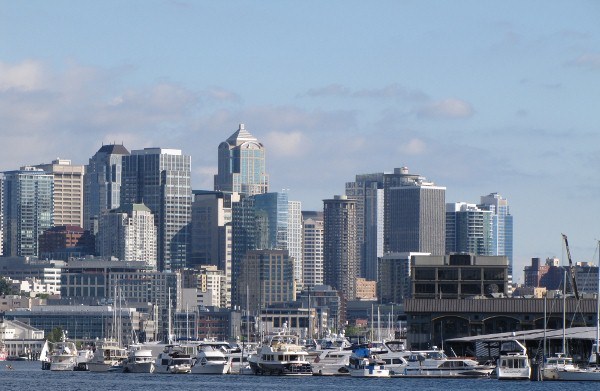.jpg)
%20(400x300).jpg)
.jpg)
.jpg)
.jpg)
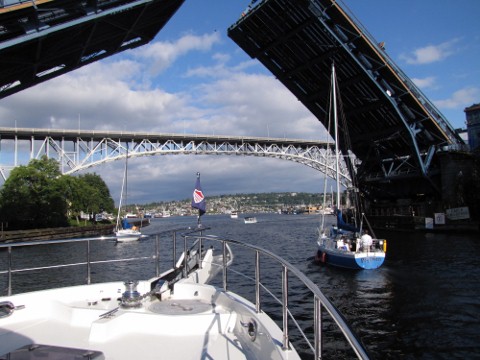.jpg)
The Lake Washington Ship Canal connects the Ballard Locks with Lake Washington. The first leg, the Fremont Cut, runs from the locks to Lake Union. The Fremont Cut has a long tradition of maritime industry. Fisherman’s Terminal there is home to most of Seattle’s commercial fishing fleet, including boats from The Deadliest Catch. Foss Maritime‘s headquarters are nearby. Just beyond our eventual destination, Canal Boatyard, is Kvichak Marine Industries. Docked outside their facility were three beautiful pilot boats bound for The Netherlands. The capable-looking craft are powered by twin Cat C32 ACERT 12-cylinder 1,300 HP engines and have top speeds of 28.5 knots fully-loaded.
.jpg) |
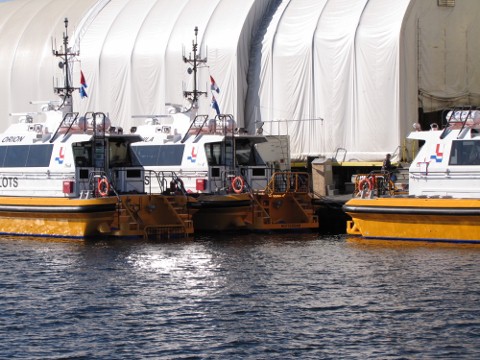.jpg) |
East of the Aurora Bridge, the Fremont Cut ends at Lake Union. The lake is wringed with parks, float homes, marinas and restaurants and has wonderful city views. (The picture at the top of this blog entry is looking south across Lake Union to downtown Seattle.) The lake also is home to Kenmore Air, with floatplane service throughout Washington State and southern B.C.
From Lake Union, we passed under Ship Canal Bridge and the University Bridge into Portage Bay. The final bridge on our route that day, the Montlake Bridge, spans Montlake Cut, the last leg of the Lake Washington Ship Canal. On the first Saturday in May, the waterways and streets surrounding the cut are packed with attendees and participants in Seattle Yacht Club‘s Opening Day Parade and the Windemere Cup rowing regatta. Regatta crews traditionally paint their team’s names along the cut walls.
.jpg) |
.jpg) |
%20(400x300).jpg) |
Spitfire kept a careful watch as we ran through the cut. We passed by, but not under, the SR-520 Evergreen Point floating bridge. The city of Bellevue is visible in the distance behind the bridge.
.jpg) |
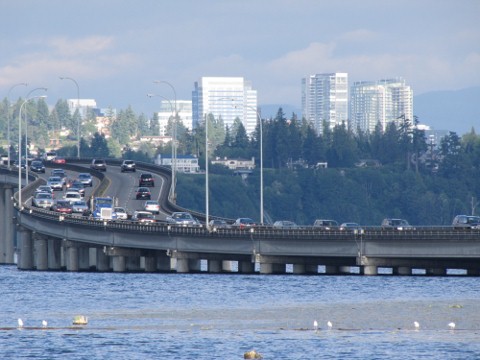.jpg) |
We anchored for the night in Cozy Cove near Kirkland, off the east shore of the lake. Multi-million dollar houses wring the shore there, but are far enough away that we still had plenty of privacy. On Hunts’s Point to our east, Microsoft CEO Steve Ballmer, singer Kenny G and cellular phone pioneer Craig McGraw own adjacent estates. The bottom left shot is the view looking north from our anchorage in the evening and the bottom right was taken late the next morning. Evenings typically are quiet on Lake Washington, but during the day boats of all sizes ply the waters. Water skiing and jet skis are popular.
.jpg) |
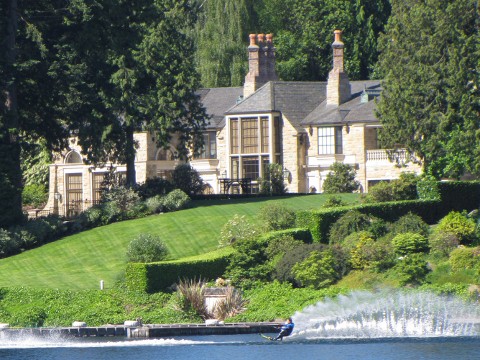%20(480x360).jpg) |
Saturday was warm and sunny, ideal for a lake cruise. We’d not navigated from the fly bridge much yet, so this also was a good chance to test the equipment. Although the pilot house definitely has the best setup, we’ve setup the fly bridge to have much the same functionality available. In addition to basic controls and equipment, we have a Maretron DSM-250 display, and a Furuno MFD8 display that hooks into the NavNet 3D system and is a backup server for the Furuno BlackBox down below. Everything worked well, and we had a great time cruising up top.
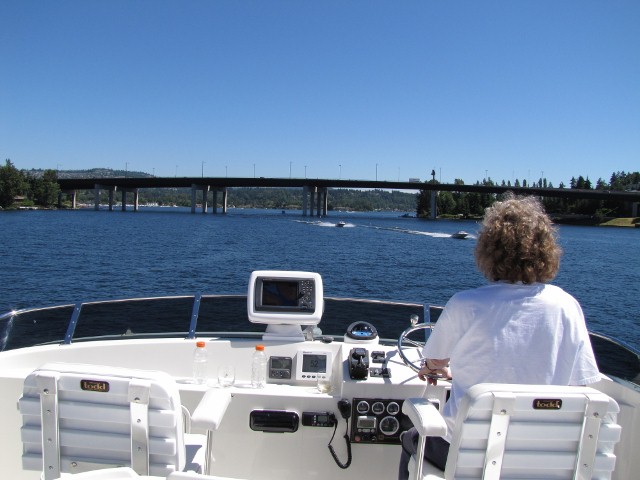.jpg)
We’d did a slow tour to the north end of the lake, then turned south and passed under the SR-520 bridge and along the east side of Mercer Island. The I-90 fixed bridge there, pictured above, has a 200′ clearance. Coming back along the west side of Mercer Island, we considered anchoring in Andrew’s Bay off the west shore, but it was literally packed with boats. We instead continued north and passed under east part of the floating portion of I-90 bridge, where the clearance is 33′. We anchored for the night off Luther Burbank Park at the northeast tip of Mercer Island. It felt a little exposed, but is the same as Andrews Bay with respect to the prevailing northerly winds, and we had it all to ourselves.
OOn Sunday, we passed under the west side of the SR-520 floating bridge, with 35′ of clearance, and reversed our path back through the Lake Washington Ship Canal to the boatyard. Traffic through Montlake Cut was a lot heavier than when we’d come through on Friday night, but was typical for a sunny summer day.
%20(480x360).jpg) |
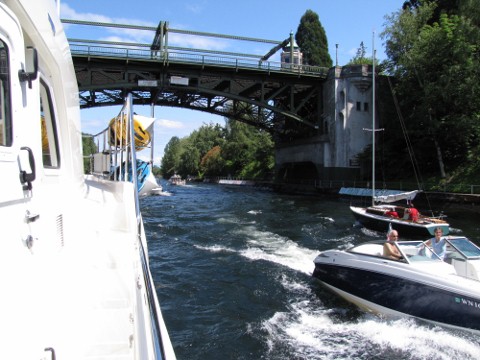.jpg) |
You did indeed see us Ian. We’re up on the lake to spend a week at the Canal Boat yard to get some work done. And, since we’re on the lake anyway we’re taking the opportunity to enjoy cruising around the area since we’re not often inside the locks.
–jrh
jrh@mvdirona.com
James,
My family and I were leaving the Fremont Sunday Market this afternoon around 1:15p and I saw you heading out through the ship canal. Your new vessel is absolutely beautiful! Congratulations!
–Ian
We’re really liking it Doug. It’s got 190 hours on it and its working out amazingly well. We can run at 9.5 kts when time matters more than money. When we were heading up to Trawlerfest in Anacortes we ran over 9.0 kts the whole way. We had committed to be there by evening and I couldn’t get off work as early as I hoped. It was nice to be able to run hard all the way from Seattle. A lower horsepower engine couldn’t have pushed the boat that quickly and running the standard intermittent duty engine at wide open throttle for long periods of time is not a good idea. We rarely use the ability to go 9 kts but love being able to do it. On the low end, we can go 6.5 kts and burn close to 3 gallons per hour. The big concern on under load is the water and oil don’t get hot and the injection system isn’t sufficiently precise to run at very low power levels. The Deere keeps heat in it at low output and the high pressure common rail system has no problem with metering precision.
We are very happy with engine and, at 190 hours, super happy with our choice.
How is your engine choice working out? Is it too much power, not enough, just right? What is the most efficient cruise speed? Just a curious Nordhavn fan, Doug